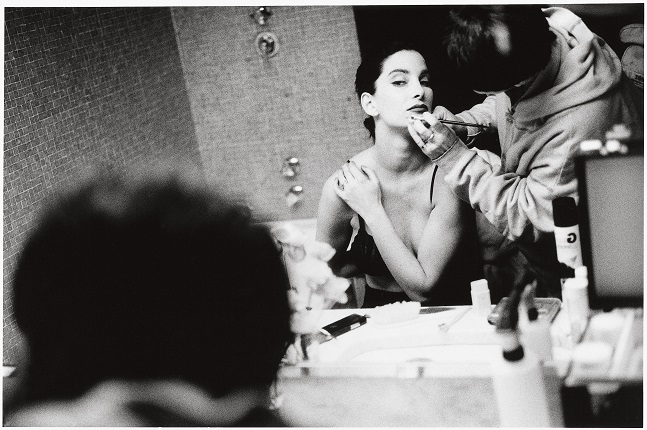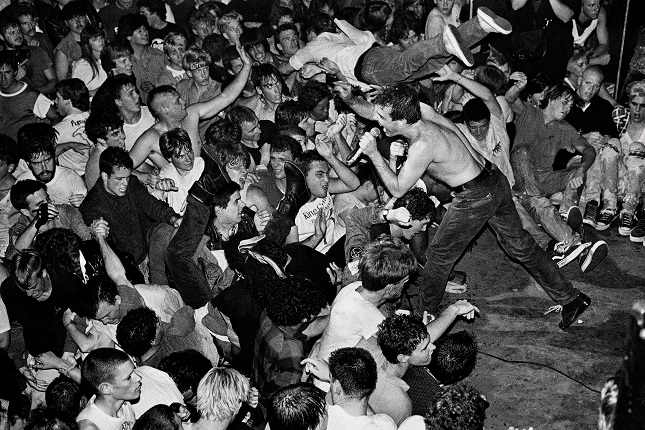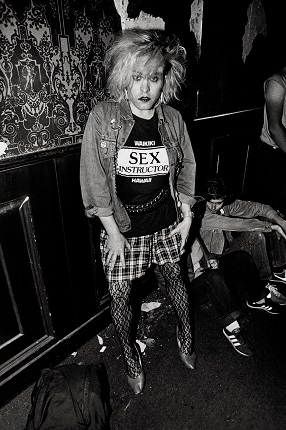Furious Beauty: The Life and Times of Stanley Greene





Stanley Greene. Meredíte being made up. France, Paris, 1988. Stanley Greene / NOOR
Stanley Greene. Jello Biafra of the Dead Kennedys performs California Über Alles, Mabuhay Gardens, North Beach, San Francisco, 1978. Stanley Greene / NOOR
Stanley Greene. Cover photo for the album Undercover for the band The Sheets, San Francisco, 1983. Stanley Greene / NOOR
Stanley Greene. Ginger Coyote, editor and publisher of Punk Globe Magazine at On Broadway, San Francisco, 1984. Stanley Greene / NOOR
Stanley Greene. North Beach, San Francisco, 1980. Stanley Greene / NOOR
Moscow, 31.01.2019—17.02.2019
exhibition is over
Share with friends
Curator: Anna Shpakova
For the press
Furious Beauty: The Life and Times of Stanley Greene
Curator: Anna Shpakova
As part of the XI Moscow International Biennnale ‘Fashion and Style in Photography 2019’, the Multimedia Art Museum, Moscow presents an exhibition of work by Stanley Greene, one of the most striking and acclaimed documentary photographers of our age, a multiple winner of the World Press Photo award and recipient of the W. Eugene Smith Grant in Humanistic Photography who for almost 30 years covered major world conflicts, crises and cultural phenomena. The MAMM exhibition showcases two early series (1975–1990), on the formation of the punk subculture in San Francisco, and fashion photographs from the Paris period in the late 1980s.
Stanley Greene (1949–2017) was born in New York to the family of a theatre director and actress. His father was a key figure in the Harlem Renaissance movement created by a group of writers, artists, musicians and actors that promoted black culture during the New York jazz era.
Greene’s interest in photography began at the age of 11, when he was given his first camera. In 1971 he met W. Eugene Smith. His acquaintance with the legendary photographer proved lifechanging when Smith offered Greene a place at his studio and advised him to enrol at the New York School of Visual Arts to learn the technical basis of photography.
As a member of the Black Panthers and a student at the San Francisco Art Institute in the mid-1970s, Greene found himself at the epicentre of the development of new cultural phenomena, with progressive artists, musicians and activists studying beside him. It was then he discovered the broader visual language of photography. The most important moments in the history of today’s music were reflected in his lens — the birth of the new wave and the punk movement. ‘I was surrounded by these rock bands, both punks and artists. In fact they were my roommates, so sometimes I took a picture... All of a sudden these groups wanted images. They’d call me and say: «Stanley, I know you got some pictures, you know, this magazine wants to do a story on us... » And at night I would go out taking photographs of the punk scene with a Leica. Unheard of! Blasphemy!’
The early shots already demonstrate the style and approach that later became Stanley Greene’s hallmark. The photographer’s complete involvement in whatever he was shooting makes these images more than documentary evidence; they reflect his precisely articulated position as an artist. ‘[The bands] they let me document them with their girlfriends, sleeping, crashing, having sex... It was one of the best, most raucous and at the same time most peaceful, times of my life. As crazy as it was. It was simple and there was a balance,’ said Greene.
After ten years of shooting the San Francisco art scene, in 1986 Stanley Greene relocated to Paris, city of the ‘fête éternel’, where he joined a group of photographers that dubbed themselves the ‘poets of photography’. He created his own image of Paris nightlife, filled with reminiscences of Brassaï and Ed van der Elsken. ‘I lived on bread, wine and cheese and took photographs of everything that moved,’ Greene wrote of this period. The photographer’s shots of Paris recount the flow of events he experienced and give the viewer an emotional sense of the atmosphere around these occurrences.
Influenced by the films of Brian De Palma, Francis Ford Coppola and David Lynch, and by Antonioni’s ‘Blow-Up’, Stanley Greene was drawn by the idea of becoming a fashion photographer and in the late 1980s began working with the glossy magazines. The collaboration was extremely fruitful, but very short-lived. In 1989 Stanley Greene travelled to Berlin and witnessed the fall of the Berlin Wall. This event turned out to be another turning point in his career. His photograph ‘Kisses to All’, with a girl in a tutu standing on the wall and opening a bottle of champagne, was spread across the pages of all major magazines and brought the photographer instant fame. ‘I stood in a crowd of people shouting that they wanted to be part of the free world and found that the camera is a powerful instrument’. From that moment Stanley Greene devoted himself to photojournalism. In 1991 he joined VU, the legendary Paris photo agency. From 1993 onwards he worked for publications such as Libération, Paris Match, Time, The New York Times Magazine, Newsweek and Le Nouvel Observateur. In October 1993 Greene was the only foreign journalist working at the White House in Moscow during the attempted coup. Two of his images from this series received prestigious international awards from World Press Photo.
In the early 1990s Greene was commissioned by the French edition of Globe Hebdo to take photographs in Sudan, which was then ravaged by war and hunger. During the cholera epidemic in Rwanda and Zaire in 1994 Greene documented the work of the humanitarian organisation Doctors Without Borders as they provided aid to local people. Greene covered armed conflicts and their consequences in Iraq, Sudan, Darfur, Afghanistan, Kashmir, Lebanon and Chechnya, where he worked from 1994 to 2003. Almost thirty years’ work as a photojournalist resulted in the books ‘Dans Les Montagnes Où Vivent Les Aigles’ (Actes Sud, 1995), ‘Open Wound’ (Trolley, 2003), ‘Chalk Lines: The Caucasus’ (Edition Intervalles, 2007), ‘Black Passport’ (Schilt, 2010) and ‘The Western Front’ (André Frère Editions, 2013).
This year would have marked Stanley Greene’s 70th birthday, on February 14th.
The exhibition was only made possible by the kind assistance of the NOOR photo agency.








